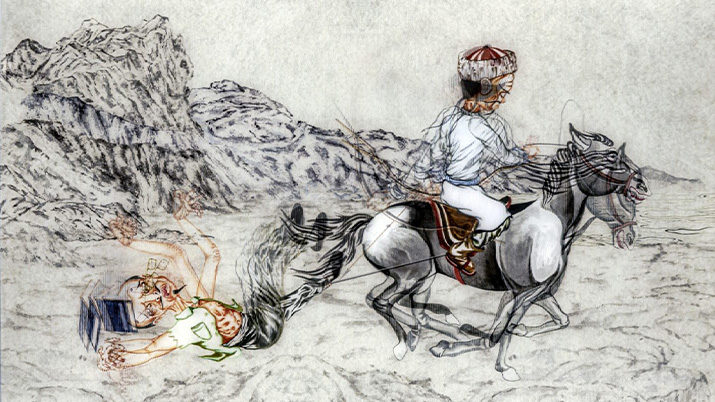Vancouver-based artist Gu Xiong spent the spring and summer of 2006 taking photographs and shooting video from boats on Winnipeg’s Red River, the Qingxi River near Chongqing in China, and the Rhine in Germany, Switzerland, and the Netherlands. Red River is the premiere of this work, which consists of a four-channel video installation with audio, photographs (often presented as a scroll or panorama), and drawings. The new work is accompanied by video documentation of drawings made by the artist between 1972 and 1976 when, as an urban, educated youth or zhiqing, he was one of many students exiled to the countryside during the Chinese Cultural Revolution. Copies of the sketchbooks are also accessible in the adjoining reading room.
Red River examines globalization by bringing together social processes, mobility of place, and cultural interaction to connect with representation, identity, and memory through commingling and juxtaposing images. Within this cultural economy, travel and rivers serve as metaphors for global configurations that are equally fluid and transnational. Nomadic patterns of globalization are explored through the centrality of global flows of technology bringing a rapid transmission of information and geographical displacement through world markets, cultural tourism, and the proliferation of real and imaginary landscapes. As Gu Xiong comments, formerly distinct geographies, economies, and cultures are transformed through “cultural entwining, splicing, convolution, and idiosyncrasy, and how these relate to present time, as we move towards global uncertainty. The work maps out a process whereby cultural clues serve only as mutations, aberrations, and misquotations.”
Immersed within the installation are images from an interactive commercial CD-ROM designed for karaoke. The journey depicted through this technology collapses time and space through picturing a global system of commerce and tourism. These elements are intertwined through the karaoke singing of “Red River Valley,” a song with broad popularity in China where it is known as a Canadian folk song. Within the installation the song lends itself to negotiate a polyphonic reading of a global cultural discourse that performs simultaneously as familiar and foreign, as conservative and liberating, as past and present, yet, neither in isolation. A karaoke machine is a functional element in the installation.
Gu received a BFA and MFA from the Sichuan Fine Arts Institute in Chongqing, China, and is an Associate Professor in the Department of Art History, Visual Art and Theory at the University of British Columbia. His work has been exhibited internationally including the China Institute Gallery in New York (2006), the Shanghai Biennale (2004), MultipleCity in Panama (2003), Le Mois de la Photo in Montréal (2001), and the Montréal Biennale (2000). His work is represented in the collections of the National Gallery of Canada, the China National Museum of Fine Arts, the Vancouver Art Gallery, and many private collections. He has completed three large public art projects in Canada and the United States; Safeco Field, Washington State Major League Baseball Stadium, Seattle; the Seattle Public Library Columbia City Branch, Seattle, WA; and MacDonald Stewart Art Centre Donald Forster Sculpture Park, University of Guelph, Ontario.
Exhibition supported by the Canada Council for the Arts.

